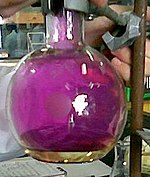Iodine
The element was discovered by the French chemist Bernard Courtois in 1811 and was named two years later by Joseph Louis Gay-Lussac, after the Ancient Greek Ιώδης, meaning 'violet'.
Due to its high atomic number and ease of attachment to organic compounds, it has also found favour as a non-toxic radiocontrast material.
[9] In 1811, iodine was discovered by French chemist Bernard Courtois,[10][11] who was born to a family of manufacturers of saltpetre (an essential component of gunpowder).
Saltpetre produced from French nitre beds required sodium carbonate, which could be isolated from seaweed collected on the coasts of Normandy and Brittany.
On 29 November 1813, Desormes and Clément made Courtois' discovery public by describing the substance to a meeting of the Imperial Institut de France.
[10][15] Ampère had given some of his sample to British chemist Humphry Davy (1778–1829), who experimented on the substance and noted its similarity to chlorine and also found it as an element.
Like the other halogens, it is one electron short of a full octet and is hence an oxidising agent, reacting with many elements in order to complete its outer shell, although in keeping with periodic trends, it is the weakest oxidising agent among the stable halogens: it has the lowest electronegativity among them, just 2.66 on the Pauling scale (compare fluorine, chlorine, and bromine at 3.98, 3.16, and 2.96 respectively; astatine continues the trend with an electronegativity of 2.2).
Similarly, the iodide anion, I−, is the strongest reducing agent among the stable halogens, being the most easily oxidised back to diatomic I2.
)[24] The halogens darken in colour as the group is descended: fluorine is a very pale yellow, chlorine is greenish-yellow, bromine is reddish-brown, and iodine is violet.
Iodine is violet when dissolved in carbon tetrachloride and saturated hydrocarbons but deep brown in alcohols and amines, solvents that form charge-transfer adducts.
[23] Due to this property iodine is commonly used to demonstrate sublimation directly from solid to gas, which gives rise to a misconception that it does not melt in atmospheric pressure.
Its former presence may be determined from an excess of its daughter xenon-129, but early attempts[31] to use this characteristic to date the supernova source for elements in the Solar System are made difficult by alternative nuclear processes giving iodine-129 and by iodine's volatility at higher temperatures.
[36] Iodine-125 has a half-life of fifty-nine days, decaying by electron capture to tellurium-125 and emitting low-energy gamma radiation; the second-longest-lived iodine radioisotope, it has uses in biological assays, nuclear medicine imaging and in radiation therapy as brachytherapy to treat a number of conditions, including prostate cancer, uveal melanomas, and brain tumours.
[38] Protection usually used against the negative effects of iodine-131 is by saturating the thyroid gland with stable iodine-127 in the form of potassium iodide tablets, taken daily for optimal prophylaxis.
In contrast, covalent iodides tend to instead have the highest melting and boiling points among the halides of the same element, since iodine is the most polarisable of the halogens and, having the most electrons among them, can contribute the most to van der Waals forces.
Both are quite reactive and attack even platinum and gold, though not boron, carbon, cadmium, lead, zirconium, niobium, molybdenum, and tungsten.
It is difficult to produce because fluorine gas would tend to oxidise iodine all the way to the pentafluoride; reaction at low temperature with xenon difluoride is necessary.
The pentagonal bipyramidal iodine heptafluoride (IF7) is an extremely powerful fluorinating agent, behind only chlorine trifluoride, chlorine pentafluoride, and bromine pentafluoride among the interhalogens: it reacts with almost all the elements even at low temperatures, fluorinates Pyrex glass to form iodine(VII) oxyfluoride (IOF5), and sets carbon monoxide on fire.
As such, iodide is the best leaving group among the halogens, to such an extent that many organoiodine compounds turn yellow when stored over time due to decomposition into elemental iodine; as such, they are commonly used in organic synthesis, because of the easy formation and cleavage of the C–I bond.
[75] For example, iodoacetamide and iodoacetic acid denature proteins by irreversibly alkylating cysteine residues and preventing the reformation of disulfide linkages.
[76] Halogen exchange to produce iodoalkanes by the Finkelstein reaction is slightly complicated by the fact that iodide is a better leaving group than chloride or bromide.
Titanium, zirconium, hafnium, and thorium are purified by the Van Arkel–de Boer process, which involves the reversible formation of the tetraiodides of these elements.
[96] The spectrum of the iodine molecule, I2, consists of (not exclusively) tens of thousands of sharp spectral lines in the wavelength range 500–700 nm.
[121] After iodine fortification programs such as iodisation of salt have been done, some cases of iodine-induced hyperthyroidism have been observed (so-called Jod-Basedow phenomenon).
Information processing, fine motor skills, and visual problem solving are normalised by iodine repletion in iodine-deficient people.
Solutions with high elemental iodine concentration, such as tincture of iodine and Lugol's solution, are capable of causing tissue damage if used in prolonged cleaning or antisepsis; similarly, liquid Povidone-iodine (Betadine) trapped against the skin resulted in chemical burns in some reported cases.
The National Institute for Occupational Safety and Health (NIOSH) has set a Recommended exposure limit (REL) of 0.1 ppm (1 mg/m3) during an 8-hour workday.
Such reactions have led to the misconception (widely held, even among physicians) that some people are allergic to iodine itself; even allergies to iodine-rich foods have been so construed.
Patients with various food allergies (fishes, shellfishes, eggs, milk, seaweeds, kelp, meats, vegetables, kombu, wakame) do not have an increased risk for a contrast medium hypersensitivity.
[138] For this reason, iodine was designated by the United States Drug Enforcement Administration as a List I precursor chemical under 21 CFR 1310.02.












